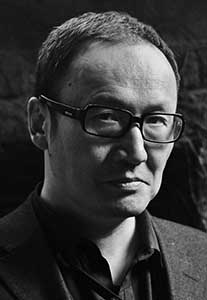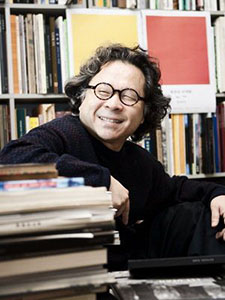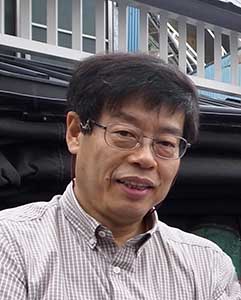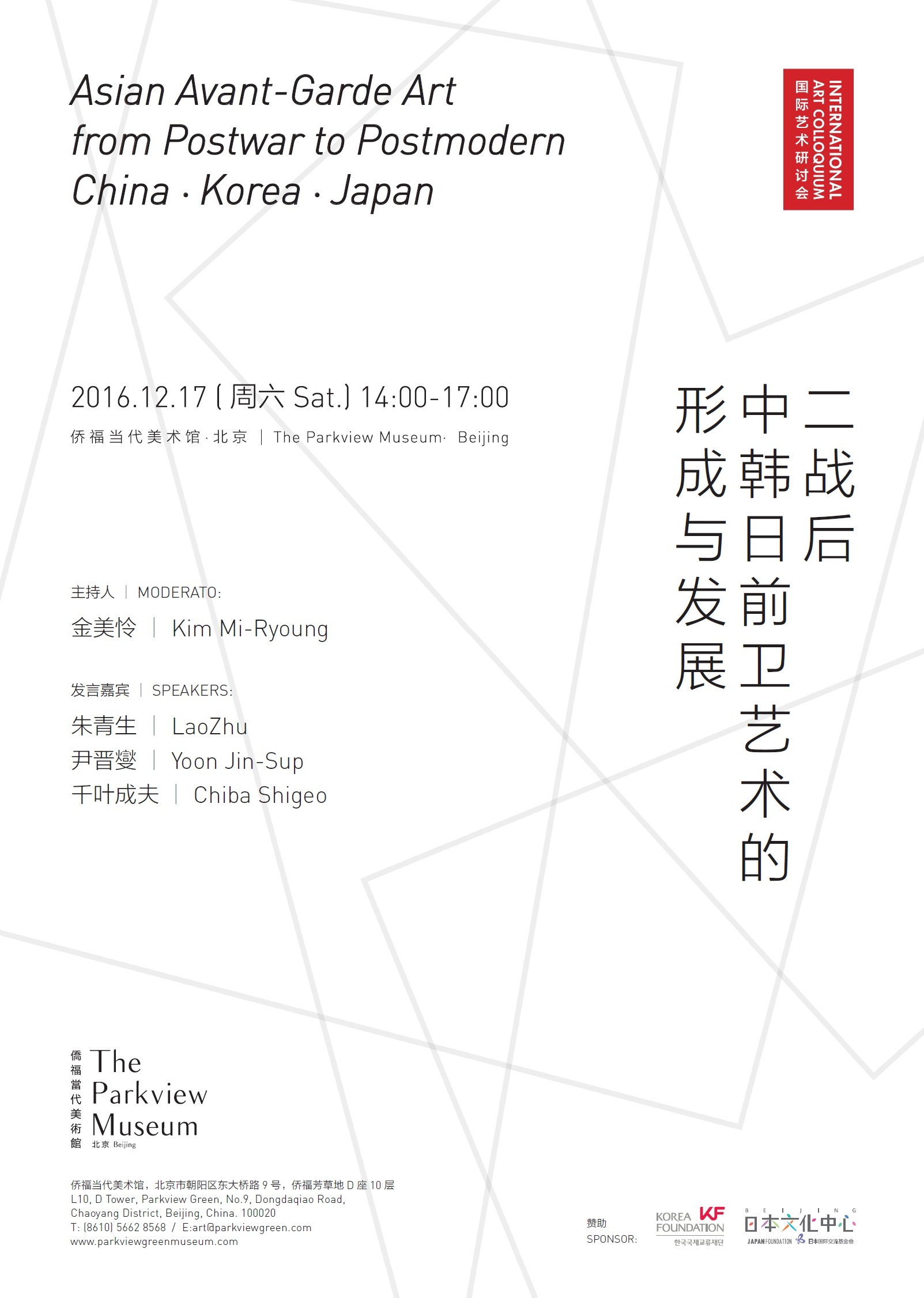Host: The Parkview Museum
Sponsor: Korea Foundation, Japan Foundation
Time: 14:00-17:00, Saturday, December 17, 2016
Place: The Parkview Museum (Beijing, China)
Moderato: Kim Mi-Ryoung (Creative Art Director ofThe Parkview Museum)
Speakers: LaoZhu, Yoon Jin-Sup, Chiba Shigeo
【ColloquiumIntroduction】
On Saturday, December 17, 2016, at2:00pm, The Parkview Museum will hold the international colloquium Asian Avant-Garde Art from Postwar toPostmodern:China·Korea·Japan. The colloquium will engage indiscussion of the development of the avant-garde art that emerged in China,Korea and Japan since the Second World War. This colloquium has invited famousscholars from the three countries: Peking University Professor LaoZhu (朱青生, Zhu Qingsheng), University of Western Sydney Professor Emeritus Yoon Jin-Sup(尹晋燮) and Chubu University Professor Chiba Shigeo (千叶成夫).
After the end of the Second World War,art around the world experienced profound and total rethinking, and carried outconstant reforms and experiments. Asian art was a relatively late entrant intothe ranks of contemporary art, but through rapid economic development andfrequent international exchange, the nations of Northeast Asia gradually beganto engage in artistic activities rooted in their own situations and totranscend simple absorption and imitation of Western contemporary art. Theperiod between the detonation of the atomic bomb in Hiroshima in 1945 and thelate 1980s marked the development of avant-garde art in Japan. Importantschools and groups that emerged in this period include Gutai (具体) Group, Hi Red Center and Mono-ha (物派). The art of Korea from the end of the Korean War in 1953 to the 1980swas highly avant-garde in nature. Korean avant-garde art first emerged with ArtInformel, whose avant-garde spirit was carried on by Group AG (avant-garde),Dansaekhwa (单色画, Korean Monochrome Painting), MinjungArt (民众美术, people’s art) and other schools. Chinese avant-garde artbegan with the No Name Painting Group (无名画会), which opposed the revolutionary realism of the Cultural Revolution.They were mainly active from the early 1960s into the 1970s. The reform andopening of 1978 brought a flood of new ideas that led to bold experiments amongthe young artists of the time. Important schools and events of the time includethe Stars Art (星星画会), the 85 New Wave, the 89 China / Avant-Garde Exhibition, etc.
This colloquium breaks with the limitations of region and places itself atthe forefront of scholarship to present and discuss the unique traits ofChinese, Korean and Japanese avant-garde art since the Second World War in acomprehensive manner. It will be a clash of academic cultures rooted in thedifferent developmental threads of art in the same era. This conference hasgained support and encouragement for its scholarly and public nature from theKorea Foundation and the Japan Foundation.
【Speakers】

LaoZhu
Topic:
Survey of Early Development of Contemporary Art inChina (1979-1995)
=========================================================================
Born in Zhenjiang, Jiangsu Province, China in 1957. PhD at Heidelberg University. President of International Association of ArtHistory (CIHA). Professor at PekingUniversity. Art historian, art criticand artist. Director of Center of VisualStudies and Director of Research Institute of Han Dynasty Art at PekingUniversity. Editor of Annual of Contemporary Art of China. Head of the “Chinese Modern Art Archive”.
Selected Publication: No one is an artist, But anyone can be an artist, etc.
Selected Curatorial Activities: Thirty Years of Body Art Performance Happening Project (BeijingMinsheng Art Museum, 2016); Social Sculpture: Beuys in China (CAFA Art Museum ,2013) , etc.

Yoon Jin-Sup
Topic:
Korean Avant-Garde Art Movements of the 1960s-1980s
========================================================================
Born in Cheon-an, Korea in1956. Honorary professor at Sydney College of the Art,The Universiy of Sydney. Former Vice President of the InternationalAssociation of Art Critics (AICA) and President of the Korean Art CriticsAssociation. Proposed the concept ofDansaekhwa (Korean Monochrome Painting).
Selected Publication: Dansaekhwa: KoreanMonochrome Painting ; Glocalismand Asian Contemporary Art ; PerformanceArt: Its Theory and Reality, etc.
Selected Curatorial Activities: K-P.O.P (Taipei MOCA, 2016); Dansaekhwa : Korean Monochrome Painting (National Museum ofContemporary Art of Korea, 2012); 1st and 3rd Gwangju Biennale Special Exhibition (Korea, 1995, 2000) , etc.

Chiba Shigeo
Topic:
The Meaning of JapaneseAvant-Garde Art from Gutai to Now
=========================================================================
Born in Japan in 1946. Phd at Universite Paris Ⅰ. Professor at the College of Humanities, Chubu University, Japan. Member of the International Association of Art Critics (AICA). Former curator at the National Museum of Modern Art, Tokyo, Japan. Specializes inArt-history, Contemporary Japanese Art, Contemporary Korean Art, Contemporary Chinese Art as well as Contemporary Western Art and Museology.
Selected Publication: Japanese Contemporary Art 1945-1985, Art as a Deviation ; Actual Situation of Art ; Japanese Art Yet to be Born, etc.
Selected Curatorial Activities: Contemporary Art of China and Japan (Busan City Museum of Art, 2010), etc.

